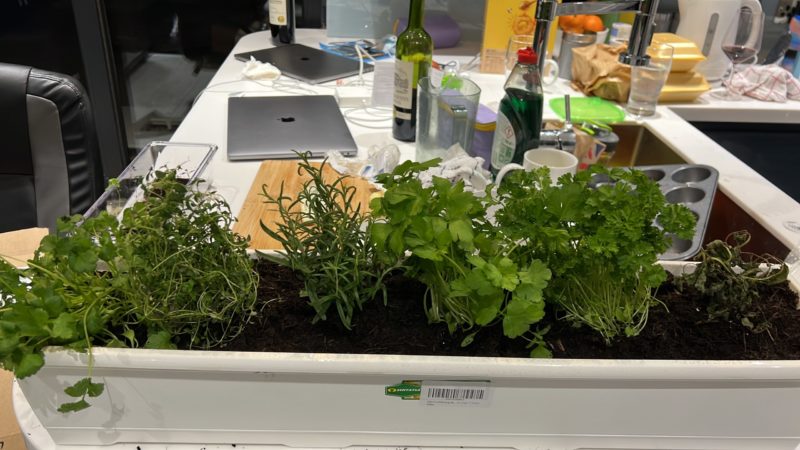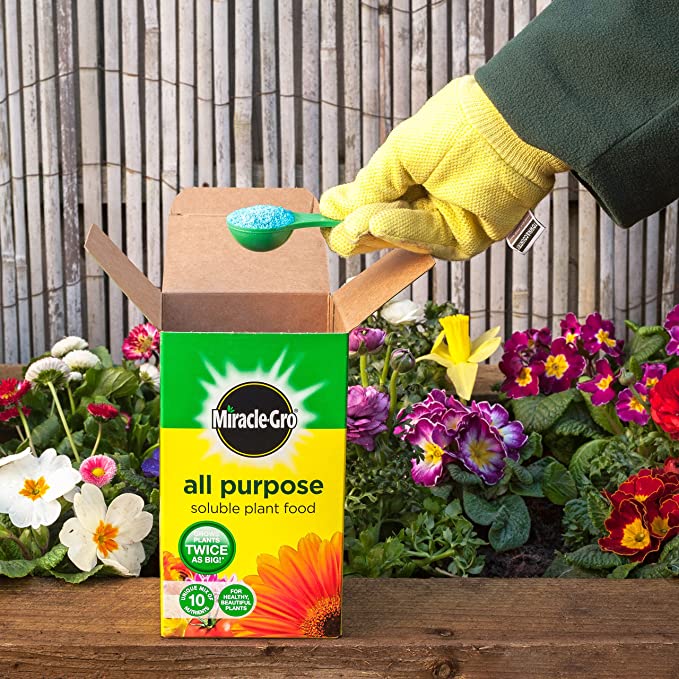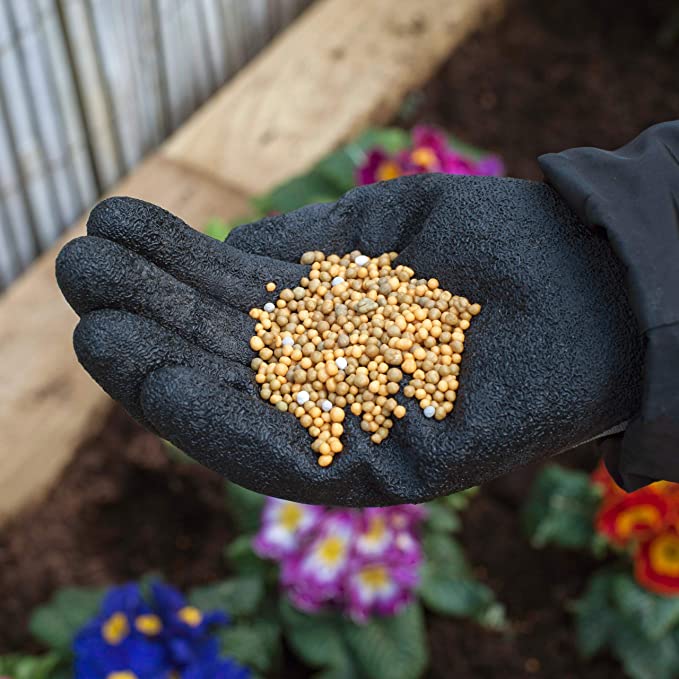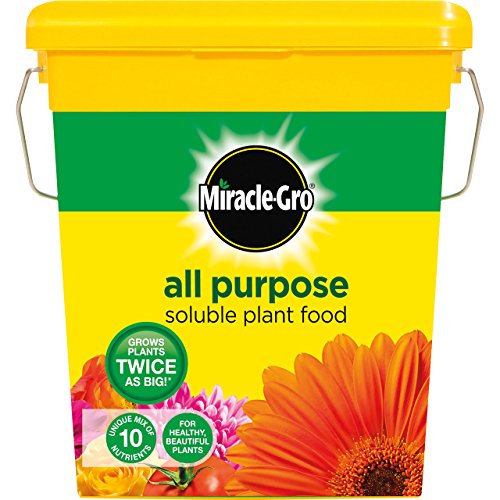Written by Terry Smith
Our site is reader supported so when you click a link to Amazon we may earn an affiliate commission.
UK’s best fertiliser options tested for herbs, vegetables, and plants
This article was last updated on February 1st, 2022 at 4:55 pm
To keep your plants, lawn, and flower beds in tip top shape, you need to treat them to a ‘fancy meal’ every now and then. Now, before you start loading your favourite shrub into the back of your car to take them to the nearest fancy restaurant, what I’m talking about is using one of the best fertilisers for plants and vegetables. But due to their differences they don’t all want the same fertiliser. A lawn normally wants a lawn fertiliser specifically or a weed and feed. Meanwhile plants vary too, and vegetables from plants. So I take a look at the best fertilisers and test them on a variety of plants, vegetables, and herbs so we can be sure of the best fertilisers.
When I tested bay bio for herbs I was pretty impressed – while I wouldn’t attribute all to the fertiliser, my Coriander picked up fast! Here’s a look at that:

I have to say I was impressed with the pickup of these leafy herbs (noted exception of Rosemary which isn’t leafy of course! There’s only so many nutrients for your plants and herbs to feed on in compost, once they run out, the plant loses its health and you’ll notice leaves begin to yellow and wilt. So let’s avoid that
Best fertilisers for plants, herbs and vegetables in the UK – my picks after testing:
Best fertiliser for herbs: Baby Bio Herb Food or Envii Seafeed Xtra – Baby Bio is a more rounded solution.
Best fertiliser for vegetables: Westland Fish, Blood and Bone All Purpose Plant Food or Envii Seafeed Xtra
Best fertiliser for plants: Miracle-Gro Water Soluble Plant Food Tub or Baby Bio Houseplant Fertiliser
Best fertiliser buyer’s guide
Choosing the best fertiliser out of the hundreds upon hundreds of products out there is never easy, but with this buyer’s guide we hope to make things a little easier for you. Here are a few questions to ask yourself before deciding…
How to workout what fertiliser my specific herb, vegetable, or plant needs?
There’s not doubt herbs have variations within themselves, from leafy to shrubs, but the difference is then bigger still when compared to vegetables. So what is the best way of actually knowing what my plant, herb, or vegetable needs? The answer is just too large to note, but the absolute sure way of making sure your plant is getting the right nutrients is to search specifically for say tomatoes:
“The tomato is grown worldwide for its edible fruits, with thousands of cultivars.[58] A fertilizer with an NPK ratio of 5–10–10 is often sold as tomato fertilizer or vegetable fertilizer, although manure and compost are also used. On average there are 150,000 seeds in a pound of tomato seeds.[59]“
The same applies for Parsley and so on. I’m not trying to dodge the question, but the list is endless.
What plants are you feeding – lawns, plants, vegetables, herbs?
The type of plants you intend to feed will probably play the biggest role in your decision making when it comes to your fertiliser. If you’re doing the lawn you might want a lawn spreader to save time and fertilise evenly too as well as moving onto the lawn feed page, or if you have a weed problem, weed and feed page.
However, some plants are picky when it comes to feeding and you should research this online before applying any fertiliser. For example, chilies don’t respond well to ordinary fertilisers, specially if they are fed regularly and this will actually harm them. Vegetables and herbs generally want the same fertilisers though you’ll want to zoom in at the point you’re deciding and cross reference – for example, the Envii Seafeed Xtra is almost certainly going to be suitable.
Timing
If you are regularly in the garden tending to your plants, you can use whatever type of fertiliser you like, as long as it won’t harm those specific plants, because you will have the time to monitor the plants progress and can feed them regularly.
For busier folks, a slow releasing plant food is more convenient, as you can dig it into the top soil and then not have to worry about it for a long time.
NPK ratios and what they do
NPK stands for nitrogen, phosphorous, and potassium, and these nutrients are mixed in different ratios in different fertilisers. For herbs and vegetables you typically want a mix that is well rounded or high in Nitrogen, something like 5-5-5 from the Baby Bio Herb Fertiliser is ideal. I know you’re probably thinking 5-5-5? That’s a bit weak knee in response – a general multipurpose ratio but the thing is, with so many variables, it’s actually hard to go wrong. For example, let’s say I recommended Envii Seafeed Xtra – this would be a disaster for your Veg as the Nitrogen is too low. – with so many Herbs and Vegetables having leafy greens you need your Nitrogen hit. Believe me I know all too well from my smallholding days.
So, what do these do? Well, nitrogen we just covered, is good for the plants leaves and giving them a healthy green look, phosphorous helps with root development and fruit production, and potassium helps to strengthen plants. It really is that simple, so it’s not uncommon for early stage growth (when it’s just leafy greens) to select a high Nitrogen medium/low Potassium mix and then change up as your plant matures.
As we just mentioned, researching about your specific plant’s needs is always a good idea before purchasing any fertiliser product, so you can get one that has a NPK ratio that best suits your plants. This will not only prevent any unnecessary harm to the plant, but will also promote the best growth. The best fertilisers will make sure your plants are getting all those essential nutrients needed to be at their best, and give you a garden to proud of in the process but the variability of the answer requires a more in depth search as I mentioned above with an example to help you get to the right information with no nonsense.
Picking the right fertiliser for the job – so many good choices
As gardeners, we are quite lucky when it comes down to the choice of good fertilisers and especially the best lawn feeds – this is incredible really. In fact, we are spoiled rotten, be it for flowers, vegetables, herbs, or the lawn, it can be hard to choose from all of the excellent products that are readily available to us. To try to make things a little easier, we have compiled this page of reviews of the best fertilisers, and tried to show a good selection to cover all the specific needs that different gardeners might have. Hope you enjoy.
1. Baby Bio 79900562 Herb Food, Concentrate - 175 ml
Since the article predominantly is about herbs, I’ve picked the Baby Bio Herb Food. I have to say it’s not a quick process but in time I have been impressed with the results. I’m not too sure what they really want from you, but I just add a few drops to my indoor planters which obviously contain my herbs and I feel like it’s making a difference. I water a couple of times a week with about two litres, I add 8 – 12 drops and it’s pretty lackadaisical, I never measure accurately. From years of experience the first thing I noticed when a plant lacks nourishment is new growth slows and leaves turn yellow / brown. The plant doesn’t die but feels ‘stalled’. I have to say, using Baby Bio Herb Food for Parsley, Rosemary, Chives, Oregano, and Coriander – I’d say Mint too but that’s practically invasive and I should have separated it in the containers! This differs from the standard Baby Bio in that the NPK ratios are different: 10.6-4.4-1.7 for the House plant version and 5-5-5 for this. I would say as a base coverer it’s better than Envii Seafeed Xtra which is 0.9-0.6-0. However, Envii Seafeed Xtra is good if you need high Potassium so bare that in mind.
There is no doubt from personal testing and experience my herbs do look perked up and greener when using Baby Bio Herb Food but I won’t say it’s the only option. I also like the look of Envii Seafeed Xtra which I’ve used in a separate container to great effect as well. The thing is, the super easy storage of Baby Bio gives it the edge for me.
What I also do is cut my teabags up and pour the contents on top of the pots from time to time. Accompanied by Baby Bio I feel like my herbs are getting the care they need. One thing I’ve noticed though, don’t be afraid to cut hard, my Coriander thanks me for it in the long run, especially with this Nitrogen level, leafy green spring back fast.
2. Miracle-Gro Water Soluble Plant Food Tub
Miracle-Gro is a giant in the fertilisers world, with most of their products being amongst the best-selling world-wide. Their name is one that gardeners have learned they can trust, and they have been consistently delivering top-notch fertilisers to us for as long as I can remember. With their soluble all-purpose plant food, they have definitely hit the mark again. This mix of 10 different nutrients has proven to be a big hit with gardeners, delivering on the company’s promises that this product promotes amazing growth in your plants.
It’s so easy to use, you just pop a spoonful in around 4.5 litres of normal water, and then use a watering can to apply the fertiliser around the base of your plants every two weeks during the spring to summer period.
Being granule based and soluble, this 2kg tub will last you a while, and is definitely more economical than the already prepared liquid type of fertilisers that you can buy.
Yes, you have to spend a minute or two measuring out and diluting, but it isn’t exactly a hard chore now is it? And, it’ll save you money.
This all-purpose fertilisers has an NPK balance of 24-8-16, and can be used both indoors and out. It is perfect for using on a wide range of plants, but for fruits and vegetables, I would buy a fertilisers that is designed specifically for that purpose, and the same goes for acid loving plants. For everything else though, this works wonders.
We tried it out on some hanging baskets and a bed of roses and the results were incredible!
The treated plants just looked so healthy and grew very rapidly. This is truly a product that you can count on to do what the makers say it will.

3. Baby Bio Fertiliser for Houseplants, Concentrate
There are many people out there who just don’t have the time or the space to create a wonderful garden in the traditional sense, and so decorate their conservatories, hallways and rooms with various houseplants. Essentially, bringing outdoors; indoors.
While a good all-purpose fertiliser like the Miracle-Gro product we just reviewed will do a great job, you might be wanting to try out a fertiliser that has been specifically designed to be used indoors, and that’s why we are reviewing the Baby Bio concentrate for houseplants.
Coming in concentrate liquid form, you just need to add 5-10 drops (depending on how strong you want the mixture to be) into ½ litre of water and then apply it to your potted plants every fortnight.
What you will be rewarded with are lush green leaves, and vibrant looking houseplants in no time at all. Even houseplants that are looking a little worse for wear will be rejuvenated by a regular feeding of this Baby Bio fertiliser. This product offers extremely good value for money. With a single bottle of concentrate costing only a couple of pounds, and three bottles for less than a tenner, you are getting a lot of top-tier fertiliser for your money.
The NPK ratio of the Baby Bio houseplant fertilisers is 10.6-4.4-1.7, which makes it weaker than the Miracle grow 24-8-16 top pick when compared but still good all rounder for most typical house plants, including cacti, but I wouldn’t try to use it on any house veggies you might have growing and go for a fruit and vegetable fertilisers for that instead.
This is another wonderful fertiliser product that works incredibly well, but I do have one small gripe: It is so hard to open the bottle for the first time! I’m a fairly strong bloke and I broke a sweat getting this thing open before I realised there as a trick to it. You have to compress the lid down and keep it like that as you turn it to break the seal. It might just have been me being a bit slow, but I thought it should have been more clearly marked on the bottle somewhere.
Despite the workout I got opening the bottle, I still wholeheartedly recommend this fertiliser for your houseplants.
4. Envii Seafeed Xtra - Organic Liquid Seaweed Fertiliser
More and more people are turning to organic products to feed their plants these days, and for good reason. Not only are they better for the environment, modern organic fertilisers are actually able to compete with many chemical-based products when it comes to results, making them a very serious contender for your money. When you compare this to the Baby Bio Herb fertiliser, I would say I prefer this for vegetables though – based on the value for money and organic factor.
Envii Seafeed Xtra is one of the best organic fertilisers out there and is making gardeners who grow crops very happy with the results. It’s not just a good choice for vegetables and fruits though, Envii Seafeed can be used on just about anything; plants, flowers, hedges, even your lawn. The main ingredient of this fertiliser is seaweed, Ascophyllum Nodosum seaweed to be precise, and that’s where the products dark brown colour comes from. In addition to the seaweed, Envii have added a little extra iron and amino acids to help promote growth and it works fantastically!
This is another concentrate, and so it needs to be diluted to the correct ratio, but thankfully there is a helpful guide on the back of the bottle which tells you how much to mix with the correct amount of water, and also how often to feed certain types of plants, eliminating any guesswork.
Also outlined on the bottle is the company’s processes for extracting the main ingredient of this fertiliser and also the production process, reassuring you that this is indeed a ‘green’ and eco-friendly product.
A 1 litre bottle of Envii Seafeed Xtra fertiliser will cost sensible money, but as it is concentrate you will get quite a lot of use out of that. You can also choose to buy bigger bottles in 5, 10, or 20 litre containers, with the largest costing just over 80 pounds.
For organic growers and gardeners, this is an excellent choice. It offers good value for money and really helps to promote natural growth.
5. Miracle-Gro All Purpose Continuous Release Plant Food
Modern life is a fast paced and busy affair, and for many of us, it means that we don’t get to send as long in the garden, caring for our green friends, as we would like to. This problem is compounded of you have children, and it is oh-so-easy to lose track of the last time you fed your plants with fertiliser.
To help tackle this common issue, many producers of fertiliser products have developed slow/ continuous release plant food. These granules can be mixed in with compost or easily forked into the top soil and then left there to work their magic for an extended period of time, slowing releasing the nutrients for the plants to feed on.
Without a doubt, one of, if not THE best of these, is the Miracle-Gro All Purpose Continuous Release Plant food, available for only five pounds per tub. With one tub being enough to feed around 40 plants for up to six months, that’s a bargain.
Just like the Miracle-Gro soluble product, this one has a wide range of plants that it can be used for in the garden and in the home too.
The special coating on the balls / granules is designed to only release the nutrients inside when the temperatures are right for the plants to feed, and the results only speak for themselves. The only downside of using this kind of fertiliser is that there are a few plants that don’t react well to being fed a lot such as chillies, so this isn’t the best product for them.
However, for the vast majority of plants, this is a real time saver, and can make even the busiest, absent minded, and dare I say it: laziest of gardeners look like a pro.

6. Westland Fish, Blood and Bone All Purpose Plant Food
Westland’s Fish, Blood, and Bone all purpose plant food has a N-P-K ratio of 4-7-4, and this makes it a good choice for all sorts of flowers and vegetables, helping to promote strong growth in the roots, leaves, and flowers, and this inevitably leads to a higher crop yield and beautiful blooms.
It works really well as a soil enricher too, and you just need to fork in a handful of the granules into the soil every 4-6 weeks to keep it nutrient rich and improve the results of your gardening efforts. You can also dig it straight into the planting hole with young plats to encourage fast and healthy growth, and you will be very happy with the results.
As well as the usual nitrogen, potassium, and phosphorous, Westland’s fish, blood, and bone also contains calcium and this promotes good growth and plants that remain strong throughout their lifetime. if you have pets, especially cats and dogs, you need to keep them away from this fertiliser or they will try to eat it. I personally didn’t really smell anything from it, but obviously animals can, and it seems to be very enticing for them, so dig it in to the soil well before letting the animals out.
Due to the slow release of nutrients over the space of about 5 weeks, this is a bit of a timesaving product like the Miracle-Gro continuous release plant food, and for that I think it will attract a lot of busy gardeners.
The correct amounts to be used for various plants are clearly written on the back of the tub, and it even gives you a ratio for the area to be fed which I thought was very helpful.
At mid range pricing for a 10kg tub of Westland Fish, Blood, and Bone fertiliser, it is a very well-priced product, and I would say it is worth every penny.





















